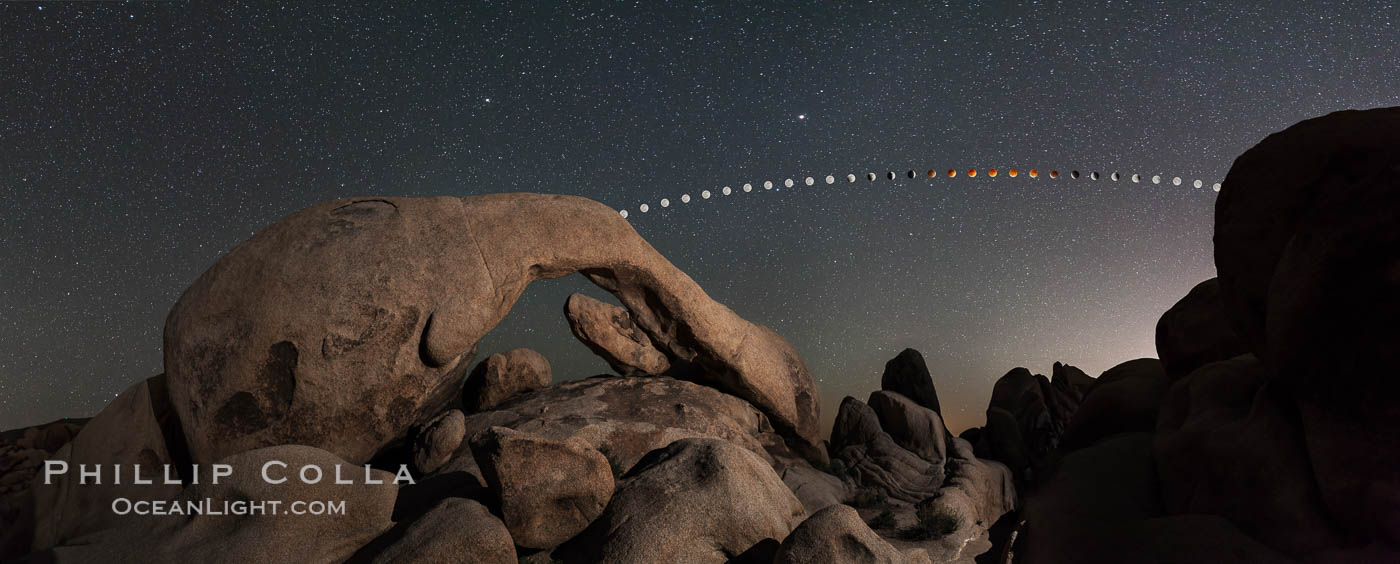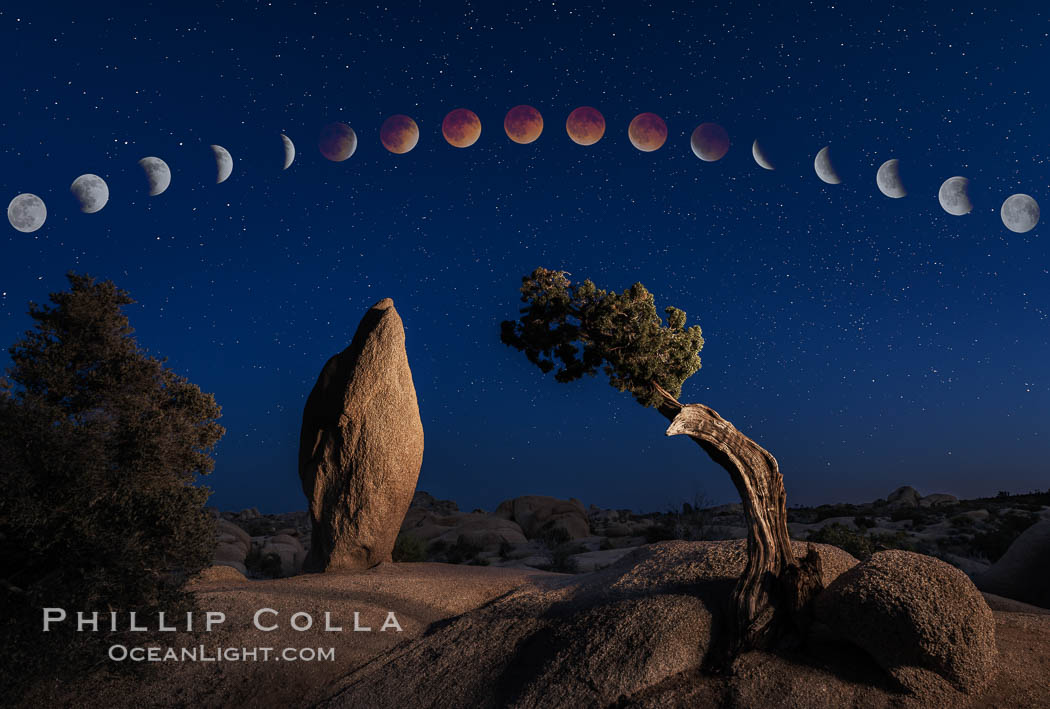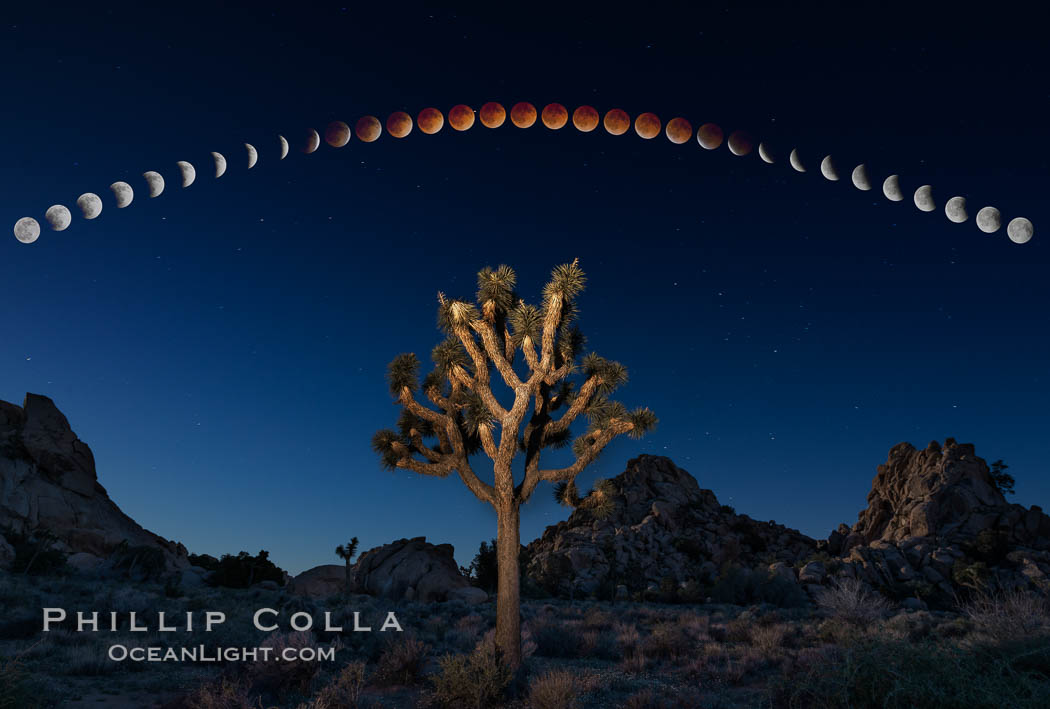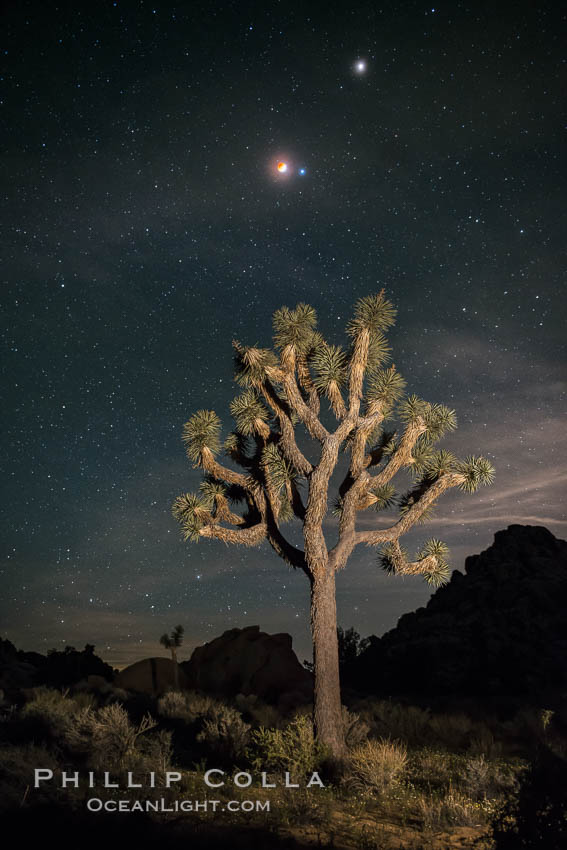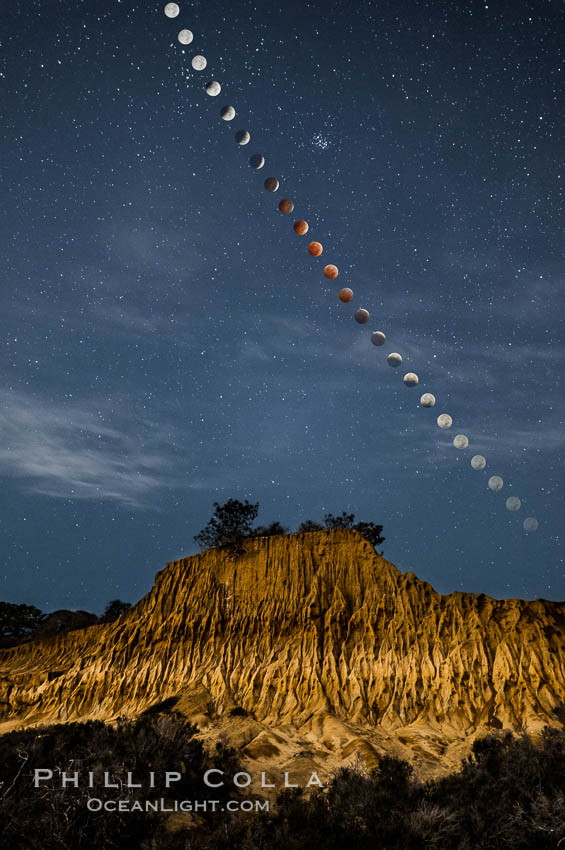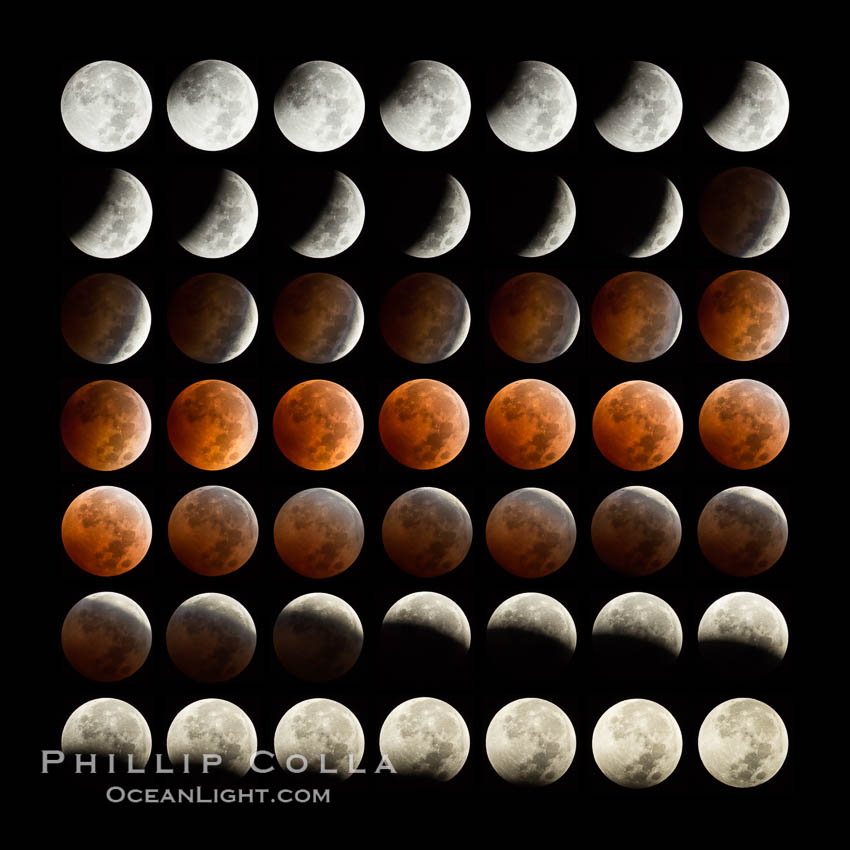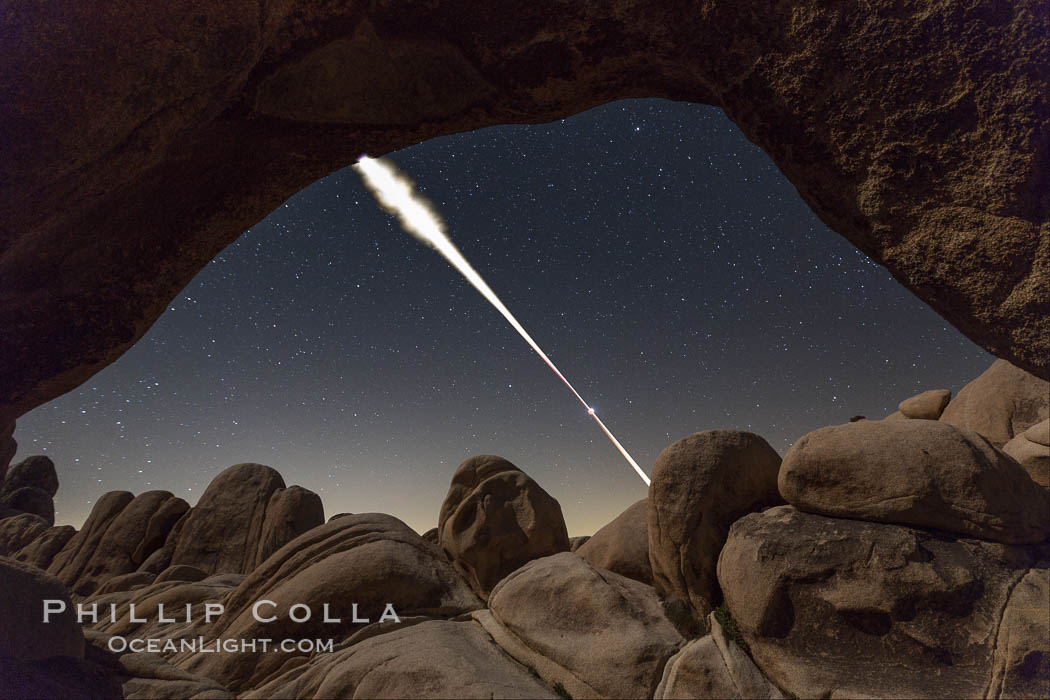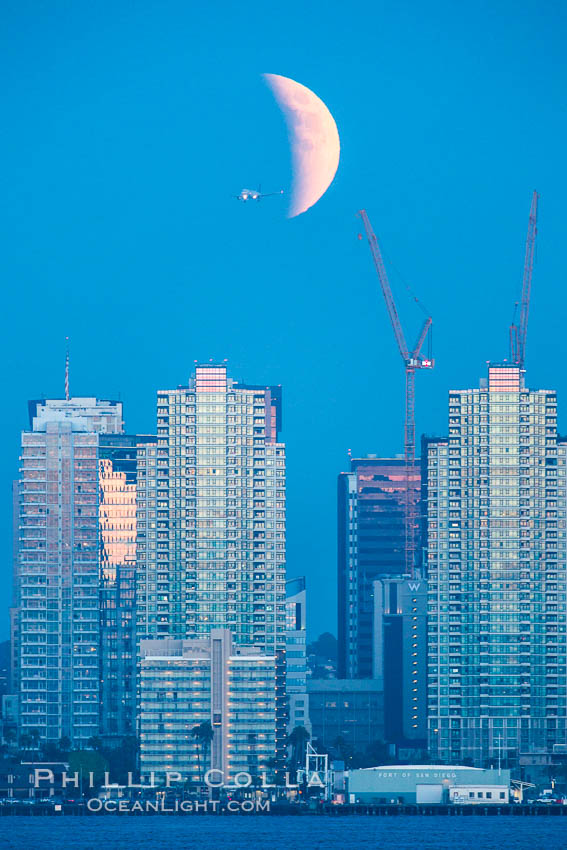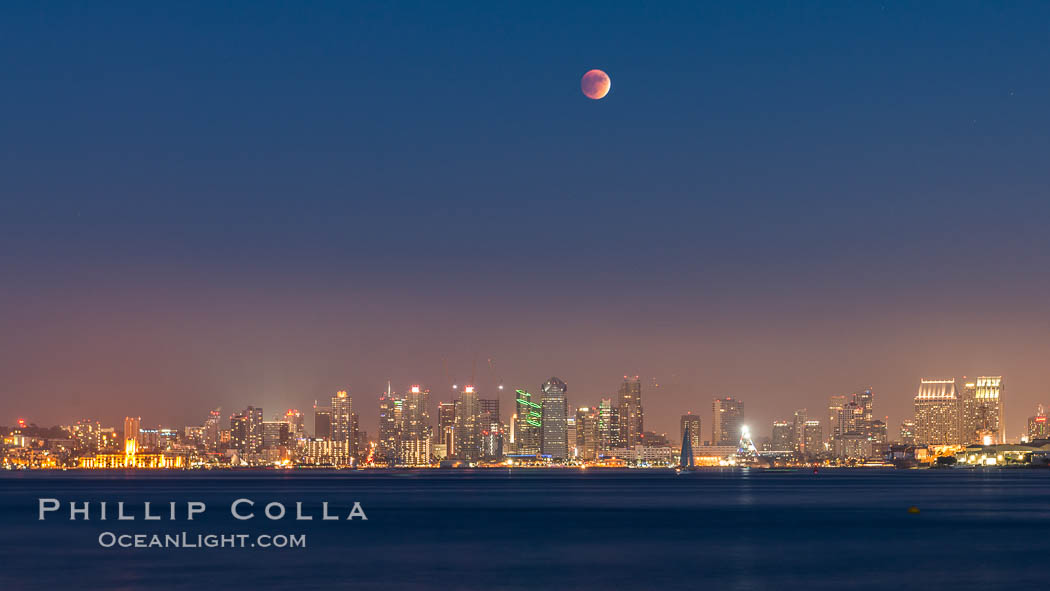Lunar eclipse sequence, showing total eclipse (left) through full moon (right). While the moon lies in the full shadow of the earth (umbra) it receives only faint, red-tinged light refracted through the Earth’s atmosphere. As the moon passes into the penumbra it receives increasing amounts of direct sunlight, eventually leaving the shadow of the Earth altogether. August 28, 2007.
Image ID: 19392
Location: Earth Orbit, Solar System, Milky Way Galaxy, The Universe
During 2014 and 2015 we were treated to a tetrad (quartet) of total lunar eclipses. For landscape astrophotography buffs, this was a big deal: each six months (lunar cycles, to be more precise) we would be offered a chance to watch the full moon pass into the shadow of the Earth and, for a while, be illuminated only by the faint light skirting the edge of the Earth rather than the direct light of the sun which normally illuminates a full moon. This “edge light” — sunlight passing obliquely through the thin atmosphere of the Earth, scattering and bending as it does — casts a faint, reddish light upon the moon that lends to oft-heard phrase “blood red moon”. Indeed, while the moon is dim during a total lunar eclipse, it is typically red, or orange, in color due to this edge light. There are even moon-geeks that have developed a scale for the gradations of this eclipse light.
I set out to photograph each of the four eclipses that would occur: April 14/15 2014, October 8 2014, April 4 2015 and September 28 2015. To my surprise, I managed to get at least one good image of each of the eclipse events. I say “surprise” because I live along the coast of California, and our skies are usually overcast. If I were a betting man I would have wagered against my chances of having clear skies for all four eclipses. I got lucky.
Prior to each eclipse, I wanted to know what lens choice would give me the best composition for a “sequence image”, in which a collage of each phase of the eclipse could be seen as the moon arced through the sky over a terrestrial landscape. There are lots of eclipse calculators out there, and using them I was able to determine, for each eclipse, the time, angle of inclination and compass degree for the moments when the partial eclipse would begin and end. Knowing these angles, it was a pretty straightforward thing to figure out what lens to use on my 35mm camera. I chose a landscape composition, setup my camera on a tripod to repeated photograph the composition with the moon passing through, and then layered the resulting images so that the moon appeared in various stages of eclipse, and positions in the sky, while the landscape below remain fixed. While it is not rocket science, I do explain a little bit more about my thinking when I posted about the April 14 2015 Lunar Eclipse.
Lunar Eclipse, April 14 2014, Joshua Tree National Park (link, link)
I had grand plans to shoot the lunar eclipse as a sequence. I went to Joshua Tree National Park since it tends to have clearer skies than the coast near my home, and is less influenced by light pollution than some other local desert options such as Anza Borrego. I had several different compositions I wanted to depict, so I set up three different cameras in three different parts of Joshua Tree National Park, and let them record the eclipse throughout the night. I then assembled the sequences into composite images. I was pretty happy with each one, but the Arch Rock Lunar Eclipse photograph is my favorite, partly because it was the most difficult to set up and partly due to the fact I love trying to photograph this one iconic arch in as many ways a possible.
Lunar Eclipse and blood red moon sequence over Arch Rock, planet Mars above the moon, composite image, Joshua Tree National Park, April 14/15 2014.
Image ID: 29201
Lunar Eclipse and blood red moon sequence, over Juniper and Standing Rock, composite image, Joshua Tree National Park, April 14/15 2014.
Image ID: 29204
Lunar Eclipse and blood red moon sequence, stars, astronomical twilight, composite image, Joshua Tree National Park, April 14/15 2014.
Image ID: 29202
Location: Joshua Tree National Park, California, USA
Full lunar eclipse, blood red moon, with blue star Spica (right of moon) and planet Mars (top right), over Joshua Tree National Park, April 14/15, 2014.
Image ID: 29205
Location: Joshua Tree National Park, California, USA
Lunar Eclipse, October 8 2014, Torrey Pines
For this eclipse I was unable to get away, and was forced to photograph it near the coast. The forecast was not good, with cloudy skies predicted. I had two ideas: Torrey Pines, and Scripps Pier, both locations I have photographed many times. I went out to the bluffs above Torrey Pines beach and checked out how the angles would work, knowing from the eclipse predictions where the moon would be passing and using that to line up the famous Broken Hill promontory below the moon’s path. I set up the camera to record all night long, and let it go. I had no idea what I would get, or whether it would even be clear enough to get any images. I also went down to Scripps Pier, but the conditions there were poor: the air was very wet, humid, and it felt like coastal fog was going to obscure the view, so I took no images there. When I finally retrieved my camera from Torrey Pines and processed the images, I was pleased to find I had recorded the entire eclipse and it was positioned right above Broken Hill as I had planned. Score one for high school geometry and the compass.
Lunar Eclipse Sequence Over Broken Hill, Torrey Pines State Reserve. While the moon lies in the full shadow of the earth (umbra) it receives only faint, red-tinged light refracted through the Earth’s atmosphere. As the moon passes into the penumbra it receives increasing amounts of direct sunlight, eventually leaving the shadow of the Earth altogether. October 8, 2014.
Image ID: 29412
Location: Torrey Pines State Reserve, San Diego, California, USA
Lunar eclipse sequence. While the moon lies in the full shadow of the earth (umbra) it receives only faint, red-tinged light refracted through the Earth’s atmosphere. As the moon passes into the penumbra it receives increasing amounts of direct sunlight, eventually leaving the shadow of the Earth altogether. October 8, 2014.
Image ID: 29411
Lunar Eclipse April 4, 2015, Joshua Tree National Park
By this time I was done with eclipse sequences depicting all the phases of the eclipse where they occurred in the night sky: I wanted to shoot something different! My friend Garry McCarthy and I decided to run up to Joshua Tree for this eclipse, primarily in an attempt to find clear skies. We also had two ideas for new images, both of which succeeded beyond my expectations. We would use Arch Rock as the focal point for these images, as we often have in the past. Garry had determined that during full eclipse the Milky Way would be positioned above Arch Rock, similar to how we usually photograph it but in this unusual case the blood moon itself would be providing the light on the arch (as opposed to light painting, as in most of these images of the Milky Way over Arch Rock). This meant we would have a chance to photograph the Milky Way during a full moon, which is normally an impossible proposition. A rare occurrence — a full eclipse in the Western sky and the fortunate location of the milky way low in the Eastern sky, all in synchony not long before dawn, made this image possible. The red color on the arch is natural in this case, as it is the light of the sun, passing through the Earth’s atmosphere, reflecting off the moon and reaching the arch. I don’t think I will have an opportunity to shoot exactly this combination of light at this location ever again.
I also placed a second camera behind the arch, pointed toward the West, to depict the moon passing through the sky. I chose to use exposures that would illustrate how the brightness of the moon wanes and waxes as it passes through the shadow of the Earth.
Lunar Eclipse Sequence, the path of the moon through the sky as it progresses from being fully visible (top) to fully eclipsed (middle) to almost fully visible again (bottom), viewed through Arch Rock, April 4 2015
Image ID: 30713
Location: Joshua Tree National Park, California, USA
Milky Way during Full Lunar Eclipse over Arch Rock, Joshua Tree National Park, April 4 2015. The arch and surrounding landscape are illuminated by the faint light of the fully-eclipsed blood red moon. Light from the sun has passed obliquely through the Earth’s thin atmosphere, taking on a red color, and is then reflected off the moon and reaches the Earth again to light the arch. The intensity of this light is so faint that the Milky Way can be seen clearly at the same time.
Image ID: 30717
Location: Joshua Tree National Park, California, USA
Lunar Eclipse September 27, 2015, San Diego
The final eclipse of the tetrad took me to Shelter Island. The moon was already partially eclipsed when it rose over the San Diego City Skyline. I managed to get one frame in which a jet plane, approaching to land at Lindberg Field, was silhouetted against the eclipsed moon itself.
Jet Airliner Silhouetted Against Supermoon Eclipse, at Moonrise over San Diego, September 27 2015
Image ID: 31869
Supermoon Eclipse at Moonrise over San Diego, September 27 2015
Image ID: 31874
Cheers, and thanks for looking!

